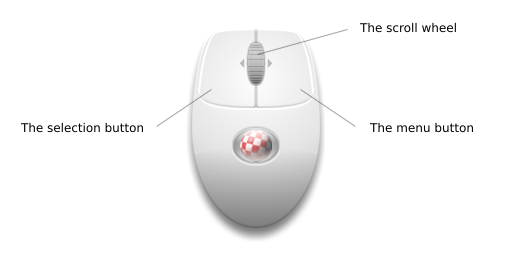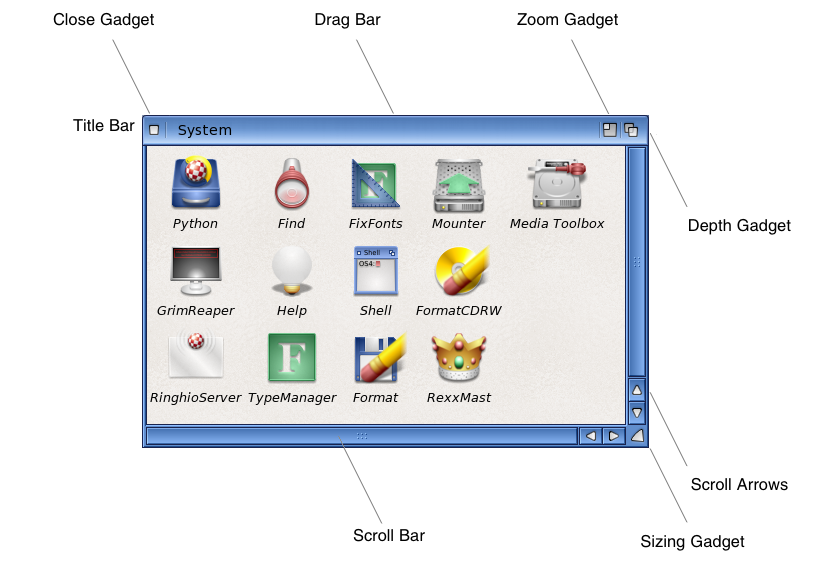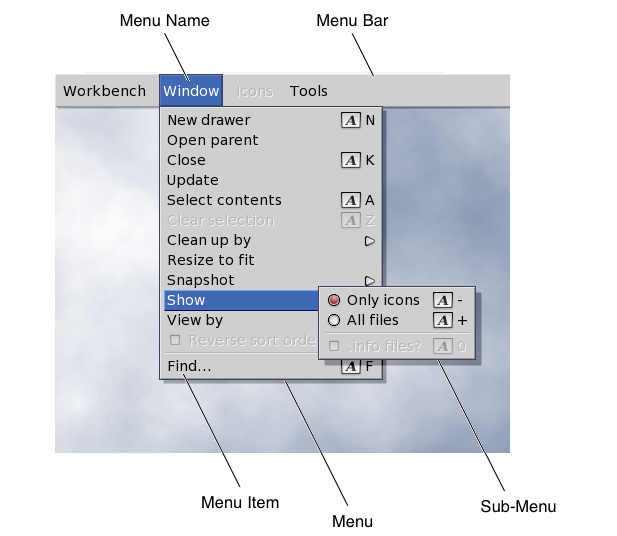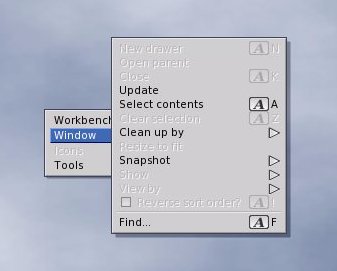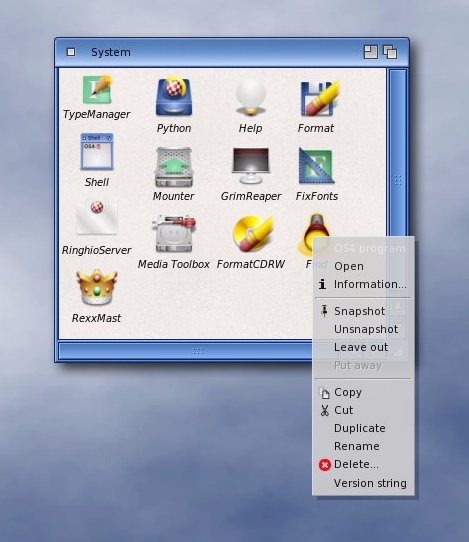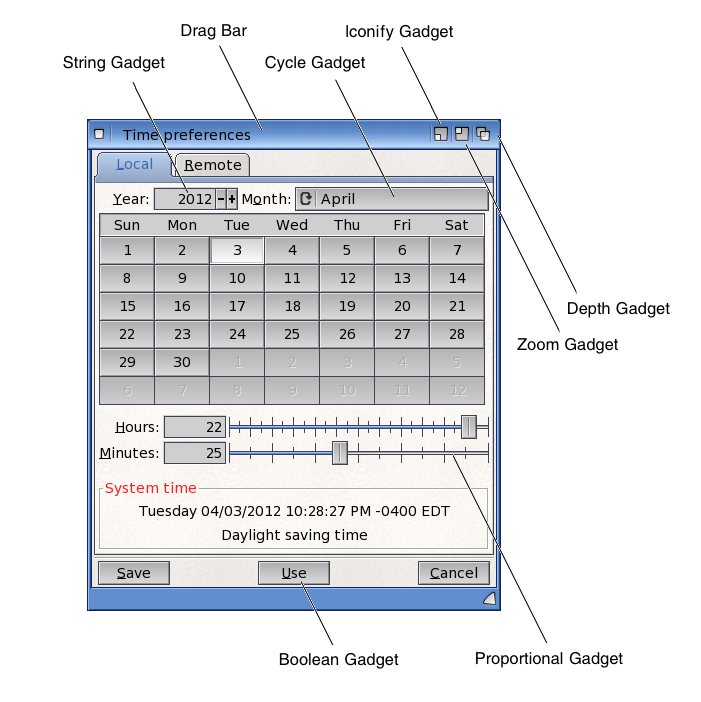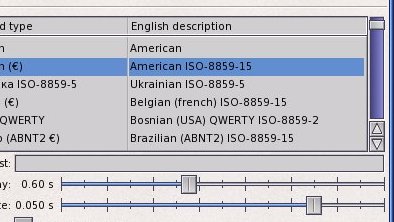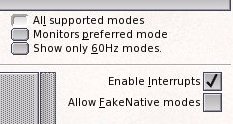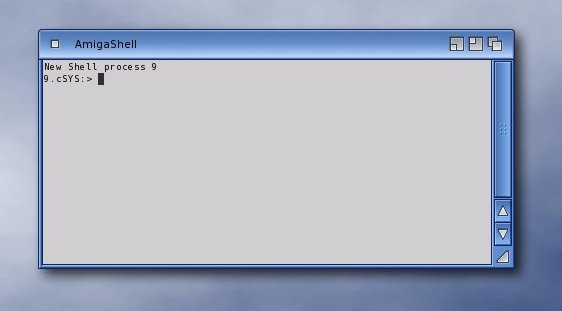Copyright (c) Hyperion Entertainment and contributors.
Difference between revisions of "UserDoc:Introduction to AmigaOS"
Paul Sadlik (talk | contribs) m (→Cycle gadgets) |
Paul Sadlik (talk | contribs) |
||
| Line 187: | Line 187: | ||
==== Check Box & Radio Button gadgets ==== |
==== Check Box & Radio Button gadgets ==== |
||
| + | |||
| + | [[File:OS4-CheckRadioGadgets.jpg]] |
||
Another variant of buttons, check boxes can be clicked to set on/off or yes/no conditions with a checkmark, just like a check box in a paper form. Radio buttons are another variant where two or more round buttons are presented in a set and only one of the set can be clicked and activated, like the buttons on a stereo system. |
Another variant of buttons, check boxes can be clicked to set on/off or yes/no conditions with a checkmark, just like a check box in a paper form. Radio buttons are another variant where two or more round buttons are presented in a set and only one of the set can be clicked and activated, like the buttons on a stereo system. |
||
Revision as of 14:56, 12 August 2012
Like any modern personal computer system, AmigaOS presents a graphic interface and relies on common peripherals to let the user control their system. Beyond most systems, AmigaOS provides more flexibility and options in how the user can approach, configure and use their Amiga computer.
In this page we will describe the details of AmigaOS graphic user interface (GUI) - how screens, windows and gadgets are presented and how you can use them. We will also describe the various means by which the user can control and operate AmigaOS. In additional pages, you can read about how AmigaOS works and what its components are.
Contents
AmigaOS Input - Point, Click and Type
There are two common ways you can use and control your AmigaOS system - by mouse and keyboard.
But AmigaOS also lets you control your system by other input devices (like touchscreens or voice recognition) depending on drivers and devices connected. Depending on software installed, AmigaOS can also be remotely controlled by networked protocols (like VNC and Synergy). Finally, AmigaOS can be controlled internal scripts set up by the User.
Using the mouse
Typically in AmigaOS, you use a mouse to act on graphic elements (like "gadgets", "icons" or webpage "links"). By default, AmigaOS expects and supports mice or trackball pointing devices with at least two buttons. The left mouse button is used to "left-click" on graphic objects, to select them or operate them. The right mouse button is used to "right-click" and display the menus of the current application.
Optionally, one can use a mouse or trackball device with three (a "middle" button) and four buttons. With such devices, the functionality of the additional buttons can vary by application or environment. These functionalities can typically be configured by the user in the application.
Furthermore, scroll wheels are supported by AmigaOS in a topical fashion. If the current application's window is scrollable, the scrollwheel will act on that area. If the mouse pointer is positioned over a specifically scrollable gadget, the scrollwheel will affect that gadget.
In some applications and environments, you can also "double-click" (click twice, quickly) with the left button on an object to engage them. In the Workbench file manager, a single mouse click will only "select" an icon, whereas a double-click will open drawer/directory, run an application or open a file in an associated program.
Beside "clicking" - pressing down and releasing a mouse button at a specific location - you can also perform what is known as "dragging", which means clicking down and then moving the mouse around before releasing the mouse button. This is typically always done with the left mouse button and is done to select objects (draw a box around them) or to resize a window.
Using the keyboard
Of course the keyboard is used to enter text into text editing areas. But your keyboard can do so much more with its special "qualifier" keys and AmigaOS.
The most common example of a qualifier key is the "Shift" key which causes typed text to be made upper-case or capitalized. There are more qualifier keys on most keyboards, here is a list of all of them:
- the Shift keys - the common key that causes your text to be capitalized.
- The "Alternate" keys - the "Alt" keys typically to the bottom right and left of the keyboard.
- the "Control" keys - the "Ctrl" keys also to the bottom right and left of the keyboard.
- the "Amiga" keys - special "A" keys on the right and left side of the space bar. Besides being unique to AmigaOS, the right and left Amiga keys always mean different things (unlike the rest of the qualifier keys, most of the time). If you have a non-AmigaOS keyboard, the "Windows" or MacOS "Command" keys function as "Amiga" keys.
- the Right Amiga key - is used for "short cuts" within your current application.
- the Left Amiga key - is used for "short cuts" that are globally active anytime and anywhere in your AmigaOS system.
While all of these qualifier keys don't usually do anything on their own, when you press and hold one or more of these keys down while pressing regular keys, they can change what you type (capitalizing or making alternate characters) or become powerful "short-cuts" within your applications or throughout your entire AmigaOS system.
The most famous short-cuts are the copy, cut and paste operations that you can perform on selected text:
- the Right-Amiga-C short-cut copies any selected text or content to the Clipboard.
- the Right-Amiga-X short-cut "cuts" any selected text or content to the Clipboard.
- the Right-Amiga-V short-cut "pastes" any text or content from the Clipboard into your application (at the current cursor location).
The AmigaOS GUI - Intuition
When AmigaOS has started, you will typically see the Workbench file manager. This is the start of your experience with the AmigaOS GUI and it's most basic elements: a screen with menus and windows containing icons and "gagdets". With all these components, you will be able to interact with the Workbench and your AmigaOS applications.
Screens
As start-up, the Workbench will be running on its "Workbench Screen". This will be the default location where most other application windows will also appear when started.
Typically an AmigaOS screen will have a "title bar" across the top with a graphical "depth gadget" at the right end. In the case of the Workbench screen, there will be an AmigaOS "boing ball" at the left end and the title bar will display certain system information (OS version, memory availability, etc.). Within the screen, the Workbench and any other applications can open windows, display icons and other GUI devices. If you right-click over the title bar, it becomes a "Menu Bar", showing you the control menus that are available for that application.
In many cases, other applications may open screens in addition to the Workbench screen. The "depth gadget" at the right end of each screen's title bar allows you to click from screen from screen. Besides clicking on the screen's depth gadet, AmigaOS also lets the user see other screens behind the front screen by "dragging' down on the screen title bar.
The characteristics of the Workbench screen such as resolution and color depth can be configured in the "Screenmode" preferences editor. Other screens can be either be configured in the "Screens" preferences editor or from within individual applications. Typically, AmigaOS applications also give the user the choice of whether application runs on their own screens or the "public" Workbench screen.
Windows
Windows are graphic containers that appear within AmigaOS screens. Windows can be created by any number of different applications - the Workbench, Shell sessions or applications.
Almost all windows of AmigaOS will have these comment elements:
- Borders - A border around the window's contents. Holding the Shift+Left-Amiga keys down while dragging any border will drag the window around.
- Title bar - A thicker top border that typically contains a name of the application or it's contents. The area of the title bar acts as a "drag bar" which you can use to drag the window around the screen.
- Depth gadget - The right-most gadget in the top title bar that either pulls the window to front (if it isn't frontmost) or pushes it to the back (if it's in front). Holding down the Shift key while clicking this gagdet pushes the window to the back.
In AmigaOS, windows may also optionally have these additional features and elements:
- Close gadget - The left-most gadget in the title bar that closes the window.
- Scroll bar(s) and arrows - If the contents of the window can be scrolled in vertically and/or horizontally, there will be a scroll bar with arrow scroll buttons. These scroll bars can also be used if the mouse pointer is over a scroll bar and the mouse scroll wheel is used.
- Zoom gadget - the second gadget from the right-most of the title bar which switches the window between two sizes. Holding down the Shift key while clicking this gadget will make it fill the screen.
- Iconification gadget - left-most of the right-hand gadgets in the title bar which causes the window to disappear into an icon on the Workbench background - thus "Iconifying" the window or application.
- Sizing gadget - In the case of windows that can be resized, this is the gadget in the bottom right corner of the window that you can drag to resize the window.
Each AmigaOS application can use almost infinite combinations of these features in the make up of their windows.
Menus
Menus are lists of items that will allow you to see and use what commands are available in an application. The Workbench uses menus you can use to perform actions on the Workbench and its contents. Menus typically provide many more functions and commands than can be presented to the user than just graphic buttons, etc. within an application's window, as a result they are a primary way most applications are used.
In AmigaOS menus can always be found for the current application by moving the mouse to the top of the screen and right-clicking. The screen title bar will become a menu bar and will show the names of all the current application's menus.
By dragging with the right mouse button, each menu will display its "menu items". Each of those menu items corresponds to a command or setting. In some cases you will find a "check box" on a menu item which you can click on to toggle a setting. In other cases, you will find that menu items have a little arrow head that indicates that item actually has a "sub-menu" - a menu within a menu. Menus ending with ellipses ("...") indicate that menu item will open a window that can be cancelled without commiting any command. For those menu items that might be deactivated (they may not apply at the moment), they will be "greyed-out".
The labels of many menu items will also include a letter or two with an "A" at the right edge. This indicates what the keyboard Right-Amiga "short cut" is the equivalent of using that menu item within that application. In the above screen shot, you can see that pressing the two keys - "Right-Amiga" and "N" - would do the same as that menu item - to create a new drawer.
Consistent Organization
For the sake of consistency (when applicable), the first two AmigaOS menus of any application are typically organized with the following hierarchy:
| First Menu:
|
Second Menu:
|
||
| PROJECT
|
EDIT
|
||
| New | = Create new project in application. | Cut | = Cut the selected content into the Clipboard. |
| Open... | = Open the file containing an existing project. | Copy | = Copy the selected content into the Clipboard. |
| Save | = Save the current project to it's current file name. | Paste | = Paste the contents of the Clipboard into the current project (at the current location). |
| Save As... | = Save the current project to a file of a new name. | Undo | = Undo the last change to current project. |
| = Print the current project. | Redo | = Restore the last change "undone" in the current project. | |
| Close | = Close the current project. | ||
| Quit | = Quit the application. |
Menu Variations
AmigaOS also includes a couple additional ways menus can be can serve the user:
Pop-Up Menus
In the GUI preferences editor you can configure menus to "pop-up" under the mouse pointer whenever you right-click the mouse. This means you do not need to move the mouse to the top of the screen to use the menus. There are also options for making menus "sticky", meaning that you don't need to drag the mouse to navigate the menus, but rather just right click and the menus stay open till you make a selection or click away.
Context Menus
The Workbench (with a utility added by default) and many applications provide "contextural menus". This means that you can put your mouse pointer over elements and right-click to pop-up a menu of things that are specific to the item you clicked over. In the case of the Workbench (with the Context Menus utility), right clicking on a file will pop-up a menu of things that could be done with that file, like deleting it.
All of these features provide both a simple means of using many functions within an application and at the same time allowing the user to configure a very efficient user interface that responds to nearly every whim.
Icons
Icons are small images which can represent a disk, a directory, an application file or data file. Icons are primarilly used within the AmigaOS Workbench environment to represent all the file system objects to be managed. The user can select these icons, open them with the mouse or delete them or move them around within the Workbench. The user can also edit the icon imagery, change how icons react to the user and adjust parameters stored within the icon file that affect how the represented file will be used.
Many applications and all AmigaOS file requesters allow Workbench icons to be "dragged and dropped" into the application or requester windows and the associated file will be recognized by the application, if possible.
Applications may also make more limited use of icons to represent file system objects or may be used as imagery in an "icon bar" of buttons that can be clicked to perform various actions represented by icon imagery.
App Icons
Many applications provide the option to be "iconified" either by clicking on an iconification gadget in their window title bars or by menu item. In those events, the application's window will disappear and an "app icon" will appear on the background of the Workbench screen. Double-clicking on the app icon will cause the icon to disappear and the application's window to reappear. Even while the application is iconified, it does continue to run and perform whatever the user may have it doing.
Some applications may also place an app icon on the Workbench background even while the application is open to allow the user to be able to drop other file icons on the app icon and have them be used by the application.
Graphic gadgets
Within AmigaOS and application windows, there can be any number of graphic devices meant to be operated by your mouse with clicks and drags - these are known as "gagdets". In most cases, the gagdets are simple analogs of real world objects - like buttons you press with your finger, forms you fill out with a pencil or tabs on folders.
Buttons
Buttons (or "Boolean gadgets") are some of the most common GUI objects. With a simple left-click of your mouse button, they are used to perform actions, set configurations or indicate choices.
In AmigaOS, clicking "down" on a button typically causes the button to be rendered differently, to reflect that it has been "pressed". Engaging the button is not actually recognized until you let go with the mouse button over the graphic gadget. This means that while the gadget has been clicked down, you always have the option of moving the mouse off the button gadget and then letting go and it will be as though the button had never been "pressed" or clicked on.
Text gadgets
A text gadget (or "String gadget") works like a space in a paper form to be filled out - left click in the gadget, you will see a cursor appear and you can type your answer. Once you've finished typing your infrormation, you can either press the enter, carriage-return or tab keys for your entry to be recognized.
Text or string gadgets can also come in a number of variants for specific uses. Some can limit input to be numeric only (and may have adjacent buttons to increment or decrement the value). Some string gadgets may be specifically be meant for file or directory names and they have adjacent gagdets that will bring up a file requester to set the value. Many times a numeric gadget is paired with a slider gadget (as in the example above), where the value can either be set by typing in the gadget or by using the slider.
Sliders & Scroll Bars
Slider gadgets work like controls many of have seen on their stereo systems - left-click and drag on the gadget "knob" to move it back and forth to set a value. A more sophisticated variant of the slider is the "scroll bar" that has a variably sized scroll bar contained in a scroll box that lets you see what proportion of the active range is visible or active.
With all slider and scroller gadgets AmigaOS also lets you click in the area to either side of the knob or slider to adjust the setting. In the case of sliders, the value will typically move by a fixed amount (+/- 1 or some suitable increment). In the case of scroll bars, clicking in the scroll box on either side of the scroll bar will cause the value to move in increments of the scroll bar size. Scroll bars also come with "scroll arrows" at the end of the scroll box that allow for finer movement of the scroll bar.
Cycle gadgets
Cycle gagdets are a variant on buttons that let you select from a number of specific choices. You can either click on the majority of the gadget to pop-up a list of choices to select from or click on the circular arrow to cycle between the list of choices. Cycle gagdets rarely cause actions to occur, they just adjust some setting or configuration.
Check Box & Radio Button gadgets
Another variant of buttons, check boxes can be clicked to set on/off or yes/no conditions with a checkmark, just like a check box in a paper form. Radio buttons are another variant where two or more round buttons are presented in a set and only one of the set can be clicked and activated, like the buttons on a stereo system.
Tabs
Tabs are a graphical gadget that is used in combination with a "pages" or sets of gadgets and/or information, and you can click on the "tabs" to switch between the pages - like you might in a real notebook with tabbed pages. This provides a efficient way to present more information and settings in a compact interface.
Controlling AmigaOS - Which Way?
AmigaOS provides a number of parallel ways that the user can control and put their Amigas to use. The easiest and most common method is to use the AmigaOS graphic icons, windows and mouse interface - the "Workbench". But AmigaOS also provides a more traditional or "old fashioned" method called a command line interface (the "CLI" or "Shell"), where the user can type text commands and interact using a text interface. AmigaOS also provides a unique means of "interprocess communications" where user can have many applications and parts of the OS "talk" to each other.
The Workbench & Intuition
The Workbench is the first thing you see when AmigaOS is fully started. As we described above, AmigaOS provides a straightforward and easy graphical means to start applications, manage your computer and all your files. Files and programs are represented with icons, generally known as "Projects" and "Tools". They can be stored in any arrangement of directories ("Drawers"). You double-click on a program icon and it will open in a Intuition GUI window on your Workbench screen.
In the following pages we will discuss the these concepts:
- What is the Workbench
- Workbench menus
- Keyboard control
- Workbench requesters
- Configuration
- Workbench help
Please see the section about the AmigaOS Workbench to learn more about it.
The Shell & DOS Commands
The AmigaOS Shell can be opened by double-clicking the "Shell" icon in the AmigaOS "System" drawer. The Shell is a text based interface that allows you to perform most of the same operations as the Workbench - to run and interact with application programs, manage files and control your Amiga computer. AmigaOS also comes with dozens of standard "DOS commands" (programs purely meant for Shell usage). Simply enter the name of a program or command (like "dir") and press Enter, the command or program will run and it will print its results in the Shell window. While considered old fashioned, many users find the Shell to still be the most efficient way to perform many tasks on the Amigas.
Please see the section on the AmigaOS Shell to learn more.
Scripts & Messages
Scripts are simple text files that contain a list of commands written in a vareity of languages: the AmigaDOS, Arexx and Python languages are provided with AmigaOS - there are many others. Each of these language has its strengths. You'll have to learn the one that suits what you want to do. You can create a script using a text editor. Then you will be able to run such script from the Workbench or from the shell (or from any other script). By using ARexx ports provided in parts of AmigaOS (the Workbench or Multiview, for example) and third-party applications, scripts can be used make your computer performa wide vareity of actions.
AmigaOS System Tools
AmigaOS comes with a variety of programs to help in the preparation of your computer. These include tools for:
- Drive preparation (Media Toolbox, Format, Format DCRW & Mounter).
- Font Handling (TypeManager & FixFonts).
- Script Languages (RexxMast and Python).
- The Shell.
- Miscellaneous Utilities (Find, Help, Grim Reaper & Ringhio Server).
AmigaOS Utilities
AmigaOS comes with a selection of utilities to assist the user, including:
- Commodities.
- Editors (Notepad, MEmacs, PrefsObjectEditor & IconEdit).
- Postscript oriented apps (AmiPDF, AmiGS & Ghostscript).
- Disk apps (PartitionWizard & RawDisk).
- Screenblankers.
- AmiDock and Dockies.
- The Unarc dearchiver.
- PlayCD.
- Miscellaneous apps (Clock, printing apps, KeyShow, install apps, etc.).
